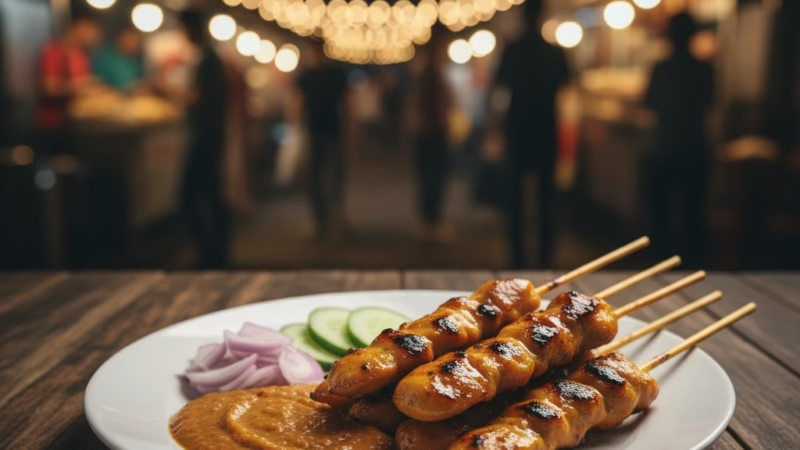Charcoal-Grilled Satay

Malaysian food
Charcoal-Grilled Satay
Origin
Southeast Asia; popular in Malaysia, Indonesia, and Singapore
Category
Street food / Grilled meat / Skewered dish
Appearance
Small skewers of marinated meat, charred edges, served with peanut sauce, sliced onions, and cucumbers
Ingredients
- Meat (chicken, beef, lamb, or goat)
- Marinade: turmeric, coriander, lemongrass, garlic, ginger, sugar, soy sauce
- Peanut sauce: roasted peanuts, coconut milk, tamarind, chili
- Accompaniments: sliced onions, cucumber, ketupat (rice cakes)
Preparation
- Cut meat into cubes
- Marinate in spiced mixture for several hours
- Skewer meat onto bamboo sticks
- Grill over charcoal until cooked and slightly charred
- Serve with peanut sauce and sides
Equipment
- Bamboo skewers
- Charcoal grill
- Mixing bowls
- Brush for oil/marinade
Variations
- Chicken Satay – tender, lightly smoky
- Beef Satay – richer flavor, marinated longer
- Lamb Satay – strong aroma, less common
- Seafood Satay – shrimp or fish variations
Taste
Savory, slightly sweet, smoky, nutty from peanut sauce
Texture
Juicy, tender meat with slightly crisp edges
Aroma
Smoky, spiced, hints of turmeric and lemongrass
Sound
Sizzling over hot charcoal; occasional crackle from fat dripping
Cultural Significance
Communal dish for festivals, night markets, and social gatherings; represents Southeast Asian culinary heritage
Symbolism
Celebration, hospitality, street food culture
Regional Cuisine
- Malaysia & Singapore: Chicken and beef satay with peanut sauce
- Indonesia: Sate Ayam, Sate Kambing, and regional sauces
Social Context
Sold at hawker stalls, roadside food carts, night markets, and food festivals
Nutritional Information
- High protein
- Moderate fats from peanut sauce
- Carbohydrates from rice cakes
Health Benefits
- Protein-rich
- Nutrients from peanuts (healthy fats, vitamins)
Dietary Restrictions
- Contains meat (not vegetarian/vegan)
- Peanut sauce contains allergens
Allergens
Peanuts, soy (from marinade), sometimes gluten (from soy sauce)
Cost
Affordable street food; approx. USD $0.50–$2 per skewer in Southeast Asia
Production
Marinated, skewered, and grilled fresh; sold in small batches
Sustainability
Depends on meat sourcing; charcoal grilling traditional but carbon-intensive
Availability
Widely available in Southeast Asia, especially at street markets and hawker centers
History
Originated in Java, Indonesia; spread throughout Southeast Asia in the 19th–20th centuries
Anecdotes
Satay competitions and festivals celebrate perfect marinade and grilling technique
How to Prepare
- Cut meat into cubes
- Marinate 2–4 hours
- Skewer onto bamboo sticks
- Grill over hot charcoal, turning occasionally
- Serve with peanut sauce, cucumbers, onions, rice cakes
FAQ
Q: Can I use an oven instead of charcoal?
A: Yes, but the smoky aroma is reduced
Q: Can satay be made vegetarian?
A: Tofu or tempeh can substitute meat with similar marinades
Q: How long should the skewers be grilled?
A: Usually 8–12 minutes, turning for even cooking








Comments are closed.